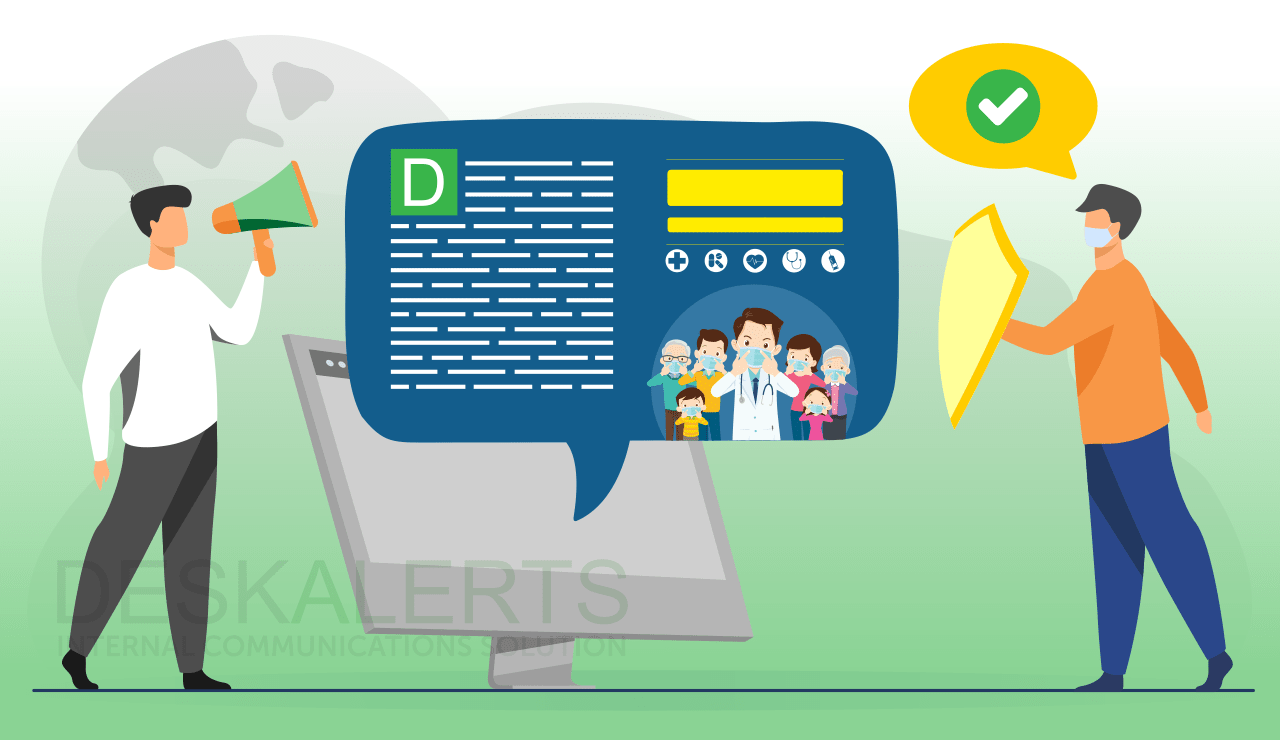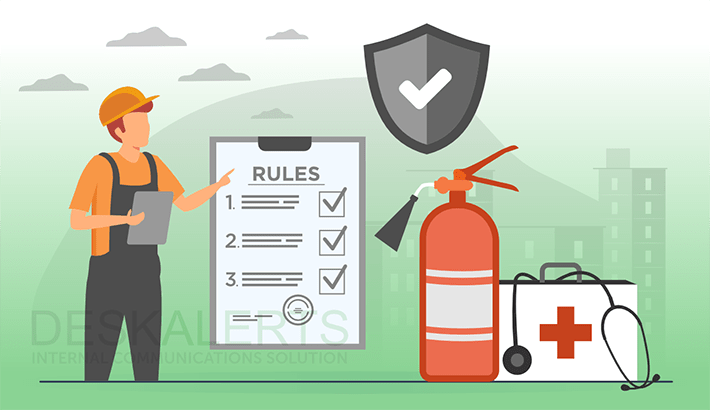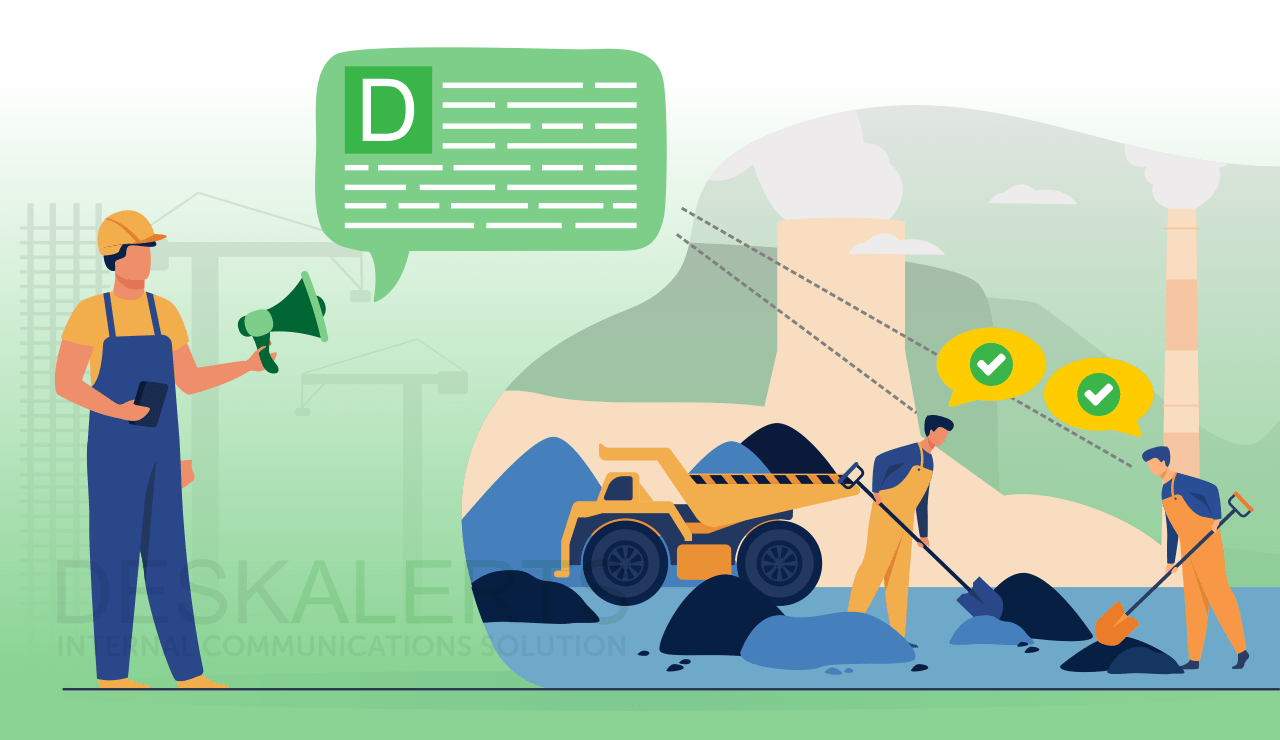16 min read
How IT Teams Keep Everyone Informed During Outages: Comms Solutions That Work
Teams is down. Tickets to the help desk flood in faster than anyone in the IT team can triage. Email is useless because half the staff can't sign...
12 min read
 Caroline Duncan
:
Sep 03, 2024
(Updated : Sep 10, 2025)
Caroline Duncan
:
Sep 03, 2024
(Updated : Sep 10, 2025)

Employees need to know the safety procedures and how to report hazards – this is good both for them and the business. A safe workplace boosts employee morale and motivation and brings many benefits to the organization overall.
A Liberty Mutual Workplace Safety Index report found that every $1 that companies invest into safety in their workplaces, they achieve a $4 return on investment.
Daily safety tips, along with broader safety messages that you send as an internal communications professional or safety manager, can help reinforce these procedures.
In this article, you’ll find tips and approaches on how you can craft, personalize, and deliver safety messages that employees actually read and act on. We’ll also share industry-specific examples.
Table of contents
1. How To Motivate Employees To Work Safely [Actionable Tips]
2. Framework For Crafting High-Impact Safety Messages Of The Day
3. Safety Messages Of The Day For Your Workplace [Examples]
4. How To Ensure Your Safety Messages Are Read [Audience Segmentation]
5. Long-Term Impact Of Daily Safety Messages
6. Quick Checklist For Writing Better Safety Messages
Internal communications professionals and safety managers often struggle to keep employees motivated when it comes to workplace safety. There are a few key ways to engage your employees on this topic and encourage them to take action:
Creating safety messages that resonate with employees is more than just sharing a rule or a reminder. High-impact safety messages are relevant, actionable, and memorable, and they consistently reinforce a culture of awareness.
Use this six-part framework to guide your safety messaging strategy:
Example (manufacturing):
“We had a spill near Line 4 yesterday. Please double-check cap seals before moving drums.”
Example (warehousing):
“Today’s reminder: Stay alert when loading pallets – we’ve had two near-misses this week in Zone 3.”
Example
Instead of: “Implement appropriate fall-prevention procedures based on [regulations]”
Use: “Use handrails and keep walkways clear — slips on stairs are one of our most common incidents.”
 Case study: Hospital Communication During Terrorist Attacks
Case study: Hospital Communication During Terrorist AttacksMany organizations struggle to make sure safety reminders are actually seen by staff. Learn how CHU Saint Pierre Hospital ensured every message reached employees instantly in a crisis.
As mentioned above, generic safety messages to employees, such as “Be safe”, “Mind your step”, or “Be aware of your surroundings” might seem like a good thing to communicate on paper, but the reality is they are so bland that they often go unnoticed.
By taking a more creative approach – either by using clever words, humor, or inspirational quotes about safety – your messaging will be more engaging and is more likely to get the cut-through that you seek.
Here are some ideas and quotes you can use directly or as inspiration.

Save your time – don't write alerts from scratch. Get ready-to-use Emergency Message Templates trusted by safety teams in hospitals, factories, and offices. Download your copy.
 Case study: Real-Time Safety Alerting for Hazardous Conditions
Case study: Real-Time Safety Alerting for Hazardous ConditionsSharing safety tips is just the start – making sure employees actually read them is the real challenge. Discover how a manufacturer ensured faster responses, better protection for employees, and reliable safety communication plant-wide → Read Case Study.
With any important cultural values that you want to embed in your organization, it’s essential to have buy-in from leadership and also have them model appropriate behaviors. Workplace health and safety is no exception to this rule. Your leadership team should walk the walk as well as talk the talk.
Sometimes, the safety tip of the day should come directly from the CEO of your company. This lends them some gravitas and shows that your company takes safety seriously and that the CEO is personally invested in ensuring that workers are safe.
Safety communication that comes from the CEO should be relevant to your organization.
If you are a construction company, safety topics for the workplace might involve communicating about risks when working at heights. For freight and logistics companies, you may have concerns about driver fatigue you would like to highlight.
Your employees want to feel safe in the workplace, and they look at management, including the CEO, to see if there is evidence of importance being placed on safety within your company. But while words are important to this process, actions are as well.
As well as sending safety messages, your CEO should also be visible and go to where the workers are, such as by participating when site visits and safety inspections are taking place. This will help make it clear to your staff that the CEO is interested in and committed to safety.
You can send workplace safety messages from the CEO in just about any format imaginable, from emails and intranet content to videos and messages on corporate social media. You don’t have to send them daily if that doesn’t suit your comms schedule: you could also introduce a “safety message of the week” concept.
Internal communication best practices recommend a multi-channel and targeted approach to distributing information to ensure the best possible reach for your messages. Let’s break down what you should consider when communicating with different employee groups.
Machine operators, drivers, warehouse staff, field technicians – these workers don’t sit at computers all day (or ever). Therefore, they might often miss email-based safety messages.
What can you do?
To keep them informed and connected, make your messages simple, highly visible, and targeted. Reach non-desktop workers through pop-up alerts, screensavers, mobile push notifications, and digital signage.
Due to the nature of hybrid work, these employees struggle with communication overload. They juggle multiple tools, such as email, Teams, and the intranet, which can be overwhelming and distracting.
What can you do?
Use pop-ups, screen overlays, visual reminders (like wallpapers or screensavers), or embedded quizzes.
When employees are spread across multiple countries, time zones, and languages, this poses challenges for internal communication. Sending one message globally at the wrong time means some regions see it late or not at all, leading to inconsistent awareness. Also, compliance regulations may differ from country to country.
What can you do?
Build relevance and trust – use tools like DeskAlerts that offer multi-language support and audience segmentation by region or team. To prevent message fatigue, schedule messages based on local working hours. Deliver content through mobile apps, SMS, or digital signage.
Prove compliance and identify engagement gaps by using platforms like DeskAlerts that log delivery, reads, and acknowledgments.

In an emergency, every second counts. Use our Emergency Message Templates to communicate instantly and keep your employees safe. Download your copy.
The long-term impact of the safety message of the day is profound, as it contributes to a sustained safety culture within the workplace.
Over time, these messages can lead to a significant reduction in accidents and near-misses by ingraining safe practices into daily routines. Employees become more aware of potential hazards and develop a mindset focused on prevention.
This ongoing commitment to safety fosters a sense of shared responsibility among the workforce, leading to a safer, more productive work environment. Moreover, a consistent focus on safety can improve morale, as employees feel valued and protected, which can contribute to overall job satisfaction and retention.
When creating safety messages for work, the following points should help guide you:
Workplace safety is important to every employee in your company, from the CEO down. Promoting awareness about specific hazards and threats through consistent safety messages, including a safety tip of the day, ensures safety remains a top priority in an easy-to-understand and accessible way.
From daily tips to life-saving alerts, safety communication must be fast, consistent, and auditable. DeskAlerts makes it possible — with multi-channel delivery and acknowledgment tracking → learn more about our Safety Communication Solution.
A daily safety message, also called a "safety message of the day," is a short reminder shared with employees to reinforce safety protocols and reduce workplace risks. These messages are typically one-sentence tips delivered at the start of a shift, during toolbox talks, or via internal communication tools like DeskAlerts.
To write better daily safety messages, keep them short, simple, and relevant to your employees’ work environment to ensure clarity and engagement. Avoid jargon, use positive language to encourage desired behaviors, and make the messages memorable through creative language like metaphors or puns. Whenever possible, enhance the impact with visuals such as images or videos.
Safety messages of the day are essential for maintaining a culture of safety within any workplace. They serve as daily reminders that keep safety at the forefront of employees' minds, helping to reduce the likelihood of accidents or injuries.
Regular exposure to safety advice encourages employees to think critically about their actions and surroundings, promoting a proactive approach to hazard identification and risk management. Additionally, these daily tips can address specific risks relevant to the tasks at hand, ensuring that safety remains relevant and adaptable to changing conditions.
Talking effectively about safety in the workplace should involve having open conversations where you listen to any concerns employees may have about safety, as well as any suggestions they have about making improvements. The conversations should be informative and positive so that important safety information is received.
It’s important to communicate well about safety so that you can be sure that the important safety information you need to impart flows through your organization unimpeded, you build trust with employees, and also build a culture of safety within the company.
Seven tips for effective safety communication are:
Good safety messages should be memorable, such as a slogan. These are statements, sentences, mottos, or phrases that organizations can use in various ways, such as on posters and internal marketing material, to encourage and remind employees about the importance of safety and reinforce safety messages that are relevant to your workplace.
An example of a powerful safety message to employees is as follows:
“Prioritize your safety - and everyone else’s! Wear your PPE properly, report hazards, and follow the appropriate procedures. Let’s create a secure and safe workplace together!”
Inspirational safety message examples include:
Foster a safety culture in your workplace by promoting open communication and the importance of recognizing safe work practices. You should also provide regular training on safety matters and ensure everyone knows the role they have to play in keeping themselves and others safe.
Express gratitude to your team for prioritizing safety in the workplace. Thank them for their commitment to making sure the workplace is safe and for all their efforts in ensuring that well-being is a top priority. This is the ultimate safety message to employees – when you’re able to praise them for their vigilance.
Send urgent notifications to any corporate devices: PCs, phones, tablets, etc.
The high visibility combined with our 100% delivery rate guarantee. Bypass information overload. Deliver key information even if the computer is on screensaver mode, locked or sleeping.


16 min read
Teams is down. Tickets to the help desk flood in faster than anyone in the IT team can triage. Email is useless because half the staff can't sign...

8 min read
If an active shooter is on the loose, you’ll have a little-to-no warning that they are about to attempt to kill and injure people.

4 min read
If you're looking for an employee notification platform, you're likely comparing several vendors. At first glance, many promise to deliver important...

15 min read
Health and safety in the workplace needs to be front-of-mind for every business, regardless of the industry it operates in. While safety topics...

10 min read
Workplace safety and health is important for every organization, no matter how big or small. Employers have legal and moral obligations to keep their...

10 min read
Creating a safe workplace for your employees isn’t something that just happens by osmosis. Instead, it takes a concerted effort from management to...